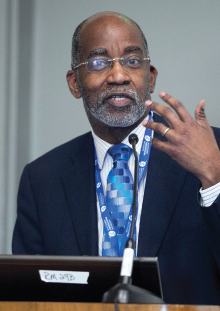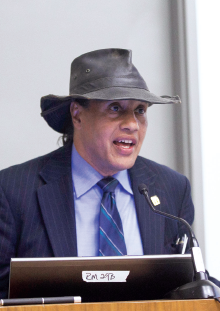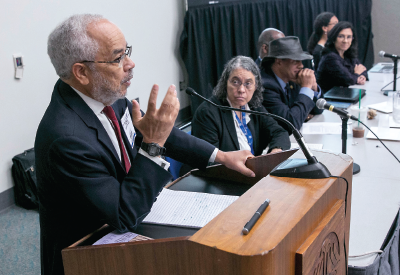Pernicious Effects of Racism Discussed in Session Honoring Chester Pierce, M.D.
Abstract
America’s troubling legacy of racial discrimination has left its mark on the health, mental and otherwise, of the nation’s minorities.
The late Harvard psychiatrist Chester Pierce, M.D., carved a path that continues to inspire his successors in the study of the connection between race and mental health in America.

David Williams, Ph.D., says that the anti-black bias of some blacks may be due to internalizing the larger society’s characterization of them.
“Racism is not simply a matter of personal prejudice but an organized system premised on an ideology of inferiority,” said David Williams, Ph.D., M.P.H., a professor of public health and sociology at Harvard University, during the Presidential Symposium “From Extreme Environments to Therapeutic Landscapes: Race, Psychiatry, and the Legacy of Chester Pierce.”
The effects of racism, particularly racially segregated housing, strongly influence health outcomes, said Williams.
“Your ZIP code matters. Where you live determines proximity to good schools, nutritious food, safe places to walk and play, good medical care, as well as to pollution and psychosocial stressors,” he said. “Socioeconomic status is a powerful predictor of health, and while gaps in socioeconomic status are greater than racial gaps, racial differences remain at all educational levels.”
Racial hostility has even been demonstrated to increase mortality among blacks subjected to discrimination, he said. Attempts to counter racism have generally tested psychosocial interventions to counter stereotypes and increase opportunities for interracial contact. However, because racism is so pervasive throughout this country, programs that address its systemic nature must simultaneously tackle numerous factors including housing, education, jobs, and the health care system.
Implicit association tests reveal that 70 percent of all Americans have an anti-black bias, and the rate among blacks is 30 percent. That may be due to internalized racism, which Williams defines as acceptance of society’s characterizations and which can adversely affect health.
“We believe that a lot of discrimination in the U.S. is implicit and occurs without intent,” he said.

Carl Bell, M.D., says that it is difficult for black people to differentiate the good will of an individual white person from collective racism of society.
Chicago psychiatrist Carl Bell, M.D., knew Pierce well and came away from their encounters with nuggets of Pierce’s hard-earned insights into American society.
Pierce often spoke of African-Americans’ confusion about dealing with racism: when and where black people should confront and fight racism and when to let it slide, said Bell. He noted the difficulty in differentiating the good will of an individual white person from the overall collective impact of society’s collective racism, and how hard it is for black people to figure out whether they are accepted or merely tolerated by white people.
“Nearly every white person you meet is going to tell you, ‘I believe in the American ideal of judging people by the content of their character not the color of their skin,’” said Bell. “But when you get left out of something or micro-insulted or locked up for breathing-while-black, you know we’ve not reached the ideal.”
A toxic combination of urban renewal, deindustrialization, planned shrinkage, gentrification, and a loss of resources, accompanied by successive waves of violence, availability of illegal drugs, and HIV infection, not only devastated American cities but never allowed their citizens to recover, said psychiatrist Mindy Fullilove, M.D., a professor at the Parsons School in New York. A study of the Hill District, a black community in Pittsburgh, found that the shared public life and social cohesion evident from 1930 to 1960 began to break down over subsequent decades.
“Urban renewal and other city, state, and federal policies tore the neighborhood apart,” said Fullilove. Ultimately, this left a level of trauma “inconceivable outside of wartime.”
Yet Fullilove is not without hope. In her hometown of Orange, N.J., she is working to expand education for citizens at every stage of life and build on the memory of Thomas Edison’s nearby invention factory.
“The past and present are the raw material for revisioning the future,” she said.
Race asserted itself in the different ways that Americans perceived and used opioids, said Helena Hansen, M.D., Ph.D., an assistant professor of anthropology and psychiatry at New York University. Illegal drugs like heroin were connected to the black and poor, while legal, prescription opioids were available for whites, she said. “We have a clinical track for whites and a criminal track for the rest,” she said.

Ezra Griffith, M.D., leads a session at APA’s 2017 Annual Meeting on the legacy of Chester Pierce, M.D. From left are Mindy Fullilove, M.D., Carl Bell, M.D., David Williams, Ph.D., Maria A. Oquendo, M.D., Ph.D., and Helena Hansen, M.D., Ph.D.
In summing up the session, Ezra Griffith, M.D., a professor of psychiatry at Yale University, noted that Pierce played an important role in the evolution of black participation in APA.
“At the 1969 APA meeting, Pierce and Al Cannon, M.D., made it clear that APA was ignoring the needs of its black members,” said Griffith. “At the time, blacks lacked a sense of belonging to APA.”
Yet Pierce always encouraged Griffith and others to join and remain in APA because “professional organizations could be landscapes where individuals can structure communities for purpose, direction, and continuity,” he said.
That APA has just completed a year with its first Latina president (Maria A. Oquendo, M.D., Ph.D.) and elected its first black president-elect (Altha Stewart, M.D.) marked another milestone in the history of the organization, he said.
Also participating in the session were Oquendo, APA CEO and Medical Director Saul Levin, M.D., M.P.A., and then APA President-elect Anita Everett, M.D.
“APA has a lot to learn from its past, from what it did and didn’t do, and I hope this conversation will continue,” said Levin. “We owe Dr. Pierce a debt of gratitude. He was a life-long advocate against disparities, stigma, and discrimination. Many of the issues that became a hallmark of his career are still critical to our patients and our profession and to APA itself.”
“Chester Pierce made a difference for so many of our members,” said Oquendo. “APA has made great strides, becoming ever more inclusive and diverse and is committed to continuing this essential work. When an organization is made up of people from many different backgrounds, it can generate more complex perspectives and greater creativity. Diversity makes our organizations, our cities, and our country a better place.”
Everett agreed. “Diversity gives us better ideas and better ways of looking at things. Diversity makes us stronger as an organization and as a profession. With diversity we are better for our patients. Figuring out how to achieve diversity so that it endures is a priority for APA, and the end result will be a stronger, more effective organization.” ■



